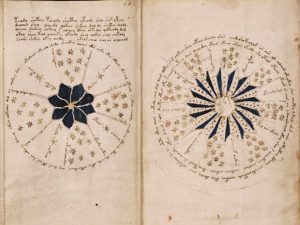Many people have heard of the Voynich Manuscript, sometimes called ‘The World’s most Mysterious Book’ but few know many of the details of this strange volume. Purchased by a Polish book dealer named Wilfrid Voynich in 1912 the manuscript consists of 240 pages that are not only written in an unknown language but which employs a completely unknown set of symbols as its script. The image below shows a close up of a section of some of the writing.

The manuscript also contains dozens of hand drawn illustrations that are if anything stranger than the writing. There are detailed drawings of plants that don’t exist, astronomical diagrams that don’t correspond to anything in our sky along with pictures of human beings, some of them nude, involved in unknown activities. Check out some of the images below to get a feel for just how strange the Voynich manuscript is.

The pages of the Voynich manuscript are vellum, which means that they are made from animal skin. The material of the manuscript has been radiocarbon dated to between 1404 and 1438 AD making it just about six hundred years old now. Presently the manuscript is a part of the Beinecke Rare Book and Manuscript Library at Yale University.

As you might guess ever since Mr. Voynich announced the discovery of the manuscript some of the world’s best linguists and cryptographers have tried to unravel its secrets. Over the last twenty years even computers have been employed in the effort to solve the mystery, all to no avail. Some researchers finally declared that in their opinion there was nothing to decipher, that the manuscript was a complex hoax perpetrated in the 15th century for an unknown reason. The whole book they believe is nothing more than a detailed and elaborate doodle.

Now a new attempt to is underway at the University of Alberta in Canada. Professor Greg Kondrak of the computing science department there along with his graduate student Bradley Hauer are using Artificial Intelligence to unlock the manuscript’s code. Using samples of 380 different languages in use today Professor Kondrak ran a series of algorithms that led him to initially conclude that the language in the Voynich manuscript was Arabic. After fine-tuning his results however the researchers decided that the language was Hebrew. Professor Kondrak now asserts that he has succeeded in connecting 80% of the ‘words’ in the manuscript to words in a Hebrew dictionary.

The researchers have even released their translation for the first line of the manuscript. “She made recommendations to the priest, man of the house and me and people.” A full translation of the text will probably require the assistance of experts in both ancient Hebrew and Jewish history so it may be several years before we learn all of the manuscript’s secrets.

Personally I’m not so confident. Other cryptographers have claimed that they had deciphered Voynich only to have their claims reversed on closer inspection. I think that the key is in those illustrations of non-existent plants and astronomical diagrams of non-existent skies. If back in the 1420s some monk or scribe enjoyed himself drawing pictures of nonsense then the ‘words’ between the pictures are probably nonsense as well.

If that is the case then we will never decode Voynich, because it simply isn’t a code. The mystery then will be what is it about human beings that we so enjoy making up these elaborate fantasies.
